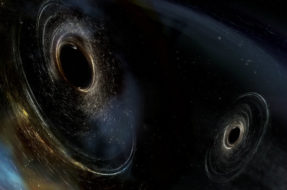Analysis by an independent team has ferreted out seven candidates for gravitational-wave events from merging black holes.

LIGO / Caltech / MIT / Aurore Simonnet(Sonoma State)
The LIGO-Virgo Collaboration has so far announced 11 detections of gravitational-wave surges from the merger of distant compact objects during its first two observing runs. The team has also so far revealed 33 candidates spotted in its ongoing third run.
But now that the data from LIGO’s first two runs are public, other groups are combing through them, too. One such group is Tejaswi Venumadhav (Institute for Advanced Study) and his colleagues, who have uncovered seven potential black hole mergers in LIGO’s public data.
The team developed its own data analysis pipeline, with different templates of gravitational-wave patterns, methods of extracting noise, and so forth. The researchers looked specifically for black-hole mergers, unlike the LIGO-Virgo Collaboration, which takes an “eyes-wide-open approach” to catch anything and everything, explains LIGO spokesperson Patrick Brady (University of Wisconsin, Milwaukee). That focused approach enables the independent team to spot quieter signals, boosting sensitivity almost as much as the improvements between LIGO’s first and second runs did, Venumadhav said during a recent colloquium at Harvard’s Black Hole Initiative.
The seven candidates involved black holes with masses similar to those seen crashing together by the LIGO-Virgo Collaboration, roughly 20 to 40 solar masses. One is from the first observing run; the rest are from the second. Most of the colliding pairs had small effective spins, a measurement that compares the speed and tilt of the two black holes’ individual spins to each other and to their orbit around each other. The most likely reasons a system would have a small effective spin are either that the two black holes didn’t spin fast or that they rolled on their sides in their orbit around each other. The confirmed mergers from the LIGO-Virgo Collaboration also had small effective spins.
Two candidate events, however, break this trend. One, called GW151216, came from a pair with an extremely rapid effective spin. Either the two black holes had similar masses and were whirling around each other like two upright tops on a table, or one was much bigger and spun much faster and more uprightly than the other. The other event, GW170403, may be the coalescence of two black holes spinning fast and backwards from the direction of their orbit. But this event is the least certain of the seven.
The LIGO-Virgo Collaboration has been discussing the results with Venumadhav’s team for about a year, and Brady for one thinks the analysis is sound.
The team isn’t the only one dabbling with LIGO data. Although the LIGO-Virgo Collaboration will still essentially be the first on the scene, we are now entering a more complex discovery landscape, where after-the-fact announcements will come from multiple groups. The collaboration has been grappling with how best to incorporate other teams’ results into its own tallies for several months. It doesn’t want to adjudicate every candidate found, but it also wants to include reasonably likely candidates and credit the discoverers.
The collaboration itself is also growing: Later this year, Japan’s Kamioka Gravitational-Wave Detector (KAGRA) will come online. Unlike LIGO and Virgo, KAGRA operates deep underground, insulated from things like wind and and ravens pecking at pipes. KAGRA likely won’t detect gravitational waves during its initial run, but over time its instruments’ performance will improve.
The LIGO-Virgo Collaboration plans to release its second catalog of events around April 2020, which will include candidates found in the third observing run’s first six months.
References:
Barak Zackay et al. “Highly Spinning and Aligned Binary Black Hole Merger in the Advanced LIGO First Observing Run.” Physical Review D. July 15, 2019.
Tejaswi Venumadhav et al. “New Binary Black Hole Mergers in the Second Observing Run of Advanced LIGO and Advanced Virgo.” Preprint posted to arXiv.org April 15, 2019.
 2
2









Comments
Diana
October 11, 2019 at 7:38 pm
My understand is that most, if not all black holes, are at the center of galaxies. So, are these merging black holes at the center of merging galaxies, or are they left over from from two prior merger of galaxies? Or, are they black holes that are not associated with a galaxy that happened to find one another in vastness of space?
Diana Wright
You must be logged in to post a comment.
Camille M. CarlislePost Author
October 14, 2019 at 10:27 am
The black holes at the centers of galaxies are a different kind of black hole than what we're talking about here. The merging black holes that LIGO and Virgo detect are the remnants of individual stars that went supernova, and they're in the 10-45 solar mass range. These can exist wherever massive stars did -- some scientists think that these black hole pairs are coming together in the centers of old star clusters. But the black holes at the centers of galaxies are millions to billions of times more massive than the Sun. These should also merge when galaxies merge, but the gravitational waves they emit are at a much lower frequency than LIGO and Virgo can detect. Scientists are building the space-based LISA interferometer to detect them.
You must be logged in to post a comment.
You must be logged in to post a comment.